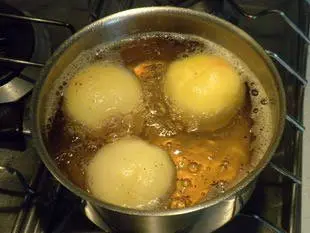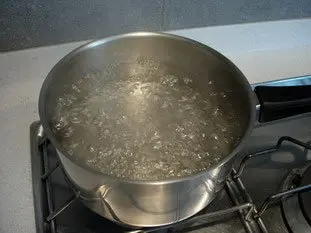This site uses only a few technical cookies necessary for its operation. By continuing to browse, you accept their use.
To find out more...
To find out more...
Sugar syrups
A syrup is simply water and sugar, brought to a boil to mix them well, and then left to cool before use.
The difference is in the ratio of water to sugar, or in other words, how much sugar do you put in how much water?
Of course, starting with 1 liter of water, all weights of sugar are possible, but there are still 2 main proportions very used.
It is used as a base for fruit sorbets, to soak babas or cookies, or to shine the top of a pastry or pastry.
It is used to poach fruits.
Syrups can be kept in a closed container in the fridge, away from the air. They can also be easily frozen.
In summary: A syrup is a mixture of water and sugar in variable proportions, the 2 most used proportions are 1 liter of water for 1 kg of sugar (heavy syrup) or 1 liter of water for 500 gr of sugar (light syrup).
The difference is in the ratio of water to sugar, or in other words, how much sugar do you put in how much water?
Of course, starting with 1 liter of water, all weights of sugar are possible, but there are still 2 main proportions very used.
The heavy syrup
It is a ratio of half and half, 1 liter of water + 1 kilo of sugar. The syrup obtained, quite thick, is called "syrup at 30" by pastry chefs.It is used as a base for fruit sorbets, to soak babas or cookies, or to shine the top of a pastry or pastry.

The light syrup
It is a different ratio, 1 liter of water + 500 gr of sugar. The syrup obtained, quite light, is called "syrup for 60" or "poaching syrup" by pastry chefs.It is used to poach fruits.

How to make it?
It's very simple, you mix sugar and water in the desired proportions in a saucepan, you bring it to boil for 1 minute, you let it cool and it's ready.Syrups can be kept in a closed container in the fridge, away from the air. They can also be easily frozen.
The degree of a syrup
As indicated above, the names sometimes refer to a degree, for example 30° for "syrup at 30", it is not a temperature, but an old measure of concentration, the Baumé degree (of the French chemist Antoine Baumé), which is obsolete but whose use, very approximate, still persists.In summary: A syrup is a mixture of water and sugar in variable proportions, the 2 most used proportions are 1 liter of water for 1 kg of sugar (heavy syrup) or 1 liter of water for 500 gr of sugar (light syrup).
Lasts posts
Butter vs. grease
We often read in a recipe where a pastry is put into a mould that, just before pouring, the mould should be buttered or greased. But what's the difference between these 2 terms?December 1st 20259085
Getting out of the fridge early
Very often when you're cooking, you need to take food or preparations out of the fridge, to use them in the recipe in progress. There's nothing tricky about this: you just take them out of the fridge and use them, usually immediately, in the recipe. But is this really a good method?November 24th 20251,0615
Who's making the croissants?
When you look at a bakery from the outside, you naturally think that in the bakery, the bakers make the bread, and in the laboratory, the pastry chefs make the cakes. It's very often like that, with each of these professions having quite different ways of working, but sometimes there's also one...November 23th 2025956
Oven height
When we put a dish or cake in the oven, we naturally tend to put it on the middle shelf, and that's what we usually do. But in some cases, this position and height can be a little tricky, so let's find out why.October 8th 20252,6315
The importance of sieving
In recipes that use a fine powder (flour, powdered sugar, etc.), you'll often see the advice to sift before using it. To sift is to pass the powder in question through a sieve (a very fine strainer) before incorporating it into your recipe. It's often advice, but is it really useful?September 3rd 20257,4653
Other pages you may also like
Cleaning endives
If you buy your endives elsewhere than in supermarkets, and in this case the best is of course from a market gardener, he or she is the one who planted and harvested them, in this case you will have endives full of earth or sand, depending on where they were grown, which is normal and reassuring, we...March 24th 202026 K4.6
The return of the "Norman hole"
You maybe know the "trou normand", this old gastronomic custom typically French which consists in taking a (small) glass of calvados, generally between the last course and the dessert? It's something that seems a bit anachronistic nowadays, having a glass of an alcohol of more than 60° in the...December 18th 202115 K4.8
How to sprinkle well?
When in a recipe you need to sprinkle something, that is to say to spread a fine layer of powder (flour, sugar, etc.) on something, powdered sugar on a pie for example, you will probably use a fine strainer or a sieve, this is the best way to proceed. But is that all?May 23th 202310 K4.7
Tranché, dissociated, failed, in short... missed!
When preparing a sauce or a cream, there's always a (small) risk that the creamy preparation you're working on will suddenly separate into two parts of different textures: a liquid part, for example, and a more or less solid part, or even become lumpy. It's terribly frustrating, but we'll see...June 19th 202313 K5
The art of the charlotte
In cooking, a charlotte is a delicious moulded dessert, with biscuits around the outside that have been soaked in a flavoured syrup, filled with a light cream or mousse. The charlotte is left to set in the fridge before being turned out and served in slices. It is very light and a lovely sweet...February 27th 201346 K4.3
Post a comment or question
Follow this page
If you are interested in this page, you can "follow" it, by entering your email address here. You will then receive a notification immediately each time the page is modified or a new comment is added. Please note that you will need to confirm this following.
Note: We'll never share your e-mail address with anyone else.
Alternatively: you can subscribe to the mailing list of cooling-ez.com , you will receive a e-mail for each new recipe published on the site.










